Machinability Investigations Based on Tool Wear, Surface Roughness, Cutting Temperature, Chip Morphology and Material Removal Rate during Dry and MQL-Assisted Milling of Nimax Mold Steel
Abstract
1. Introduction
2. Materials and Methods
2.1. Experimental Materials and Their Details
2.2. Experimental Setup of Machining Conditions
2.3. Detailed Description of Machinability Outputs
3. Results
3.1. Tool Wear Mechanism and Its Promoting Type of Wear
3.2. Surface Roughness
3.3. Cutting Temperatures
3.4. Morphology of Chips
4. Conclusions
- Chip morphology and tool wear conditions were discussed based on SEM observations. Nose wear is the principal wear type observed on the tool edges, irrespective of cutting conditions. It should be noted that the level of the nose wear varies, especially when the cutting speed and lubrication type are changed. Since nose wear is triggered by the abrasion particles expelled from both the tool and the workpiece, the abrasion mechanism is effective during the cutting of Nimax mold steel.
- Comma, c, and short curled chips are the main chip types observed during milling of Nimax steel. These types can appear alone or together under different circumstances. The main differences in chip type were seen when varying the cutting speed and lubrication type. Deep and irregular serrations were observed under dry and low cutting speed conditions. Dry cutting produces deeper serrations than when using the MQL-assisted medium.
- The cutting temperature exhibits slight changes with the different values and types of operational parameters. The cutting speed and the feed rate most significantly affected the cutting temperature. Including the MQL medium into the machining environment dramatically reduces the temperature and increases the MRR. At increased MRR values, the importance of the MQL medium increases, which can be observed by the difference between the effect of the dry medium and the MQL medium.
- On analysis of the surface roughness, lubrication is the most influential contributor among all variables. Changing the media from dry to MQL media creates a dramatic reduction in the surface roughness value. Additionally, it is clear that with the application of an MQL strategy, it is possible to increase the MRR while retaining a high-quality surface.
Author Contributions
Funding
Data Availability Statement
Conflicts of Interest
References
- Milan, J.C.; Machado, A.R.; Tomaz, Í.V.; da Silva, L.R.; Barbosa, C.A.; Mia, M.; Pimenov, D.Y. Effects of calcium-treatment of a plastic injection mold steel on the tool wear and power consumption in slot milling. J. Mater. Res. Technol. 2021, 13, 1103–1114. [Google Scholar] [CrossRef]
- Li, Z.; Zhang, J.; Dai, B.; Liu, Y. Microstructure and corrosion resistance property of laser transformation hardening pre-hardened AISI P20 plastic die steel. Opt. Laser Technol. 2020, 122, 105852. [Google Scholar] [CrossRef]
- Hoseiny, H.; Högman, B.; Andrén, H.-O.; Klement, U.; Ståhl, J.-E.; Thuvander, A. The influence of microstructure and mechanical properties on the machinability of martensitic and bainitic prehardened mould steels. Int. J. Mater. Res. 2013, 104, 748–761. [Google Scholar] [CrossRef]
- Simões, S.; Miranda, A.P.; Duarte, A.P.; Ribeiro, L. TEM Characterization of a Mould Steel in Pre-hardened Condition and After Subsequent Heat Treatments. Microsc. Microanal. 2015, 21, 51–52. [Google Scholar] [CrossRef]
- Liu, H.; Fu, P.; Liu, H.; Li, D. Improvement of strength-toughness-hardness balance in large cross-section 718h pre-hardened mold steel. Materials 2018, 11, 583. [Google Scholar] [CrossRef]
- Hoseiny, H.; Högman, B.; Klement, U.; Kinnander, A. Machinability evaluation of pre-hardened plastic mould steels. Int. J. Mach. Mach. Mater. 2012, 11, 327–341. [Google Scholar] [CrossRef]
- Morito, S.; Tanaka, H.; Konishi, R.; Furuhara, T.; Maki, A.T. The morphology and crystallography of lath martensite in Fe-C alloys. Acta Mater. 2003, 51, 1789–1799. [Google Scholar] [CrossRef]
- Ren, J.; Li, C.; Han, Y.; Li, E.; Gao, C.; Qiu, C. Effect of initial martensite and tempered carbide on mechanical properties of 3Cr2MnNiMo mold steel. Mater. Sci. Eng. A 2021, 812, 141080. [Google Scholar] [CrossRef]
- Hoseiny, H.; Klement, U.; Sotskovszki, P.; Andersson, J. Comparison of the microstructures in continuous-cooled and quench-tempered pre-hardened mould steels. Mater. Des. 2011, 32, 21–28. [Google Scholar] [CrossRef]
- Lee, F. Enhancing plastic mould steel tooling performance with Nimax. Mater. Sci. Technol. Assoc. Iron Steel Technol. 2007, 6, 3890. [Google Scholar]
- Usca, Ü.A.; Şap, S.; Uzun, M.; Kuntoğlu, M.; Salur, E.; Karabiber, A.; Pimenov, D.Y.; Giasin, K.; Wojciechowski, S. Estimation, optimization and analysis based investigation of the energy consumption in machinability of ceramic-based metal matrix composite materials. J. Mater. Res. Technol. 2022, 17, 2987–2998. [Google Scholar] [CrossRef]
- Russo, D.; Urbicain, G.; Sanchez Egea, A.J.; Simoncelli, A.; Martinez Krahmer, D. Milling force model for asymmetric end-mills during high-feed milling on AISI-P20. Mater. Manuf. Process. 2021, 36, 1761–1768. [Google Scholar] [CrossRef]
- Sartori, S.; Ghiotti, A.; Bruschi, S. Solid lubricant-assisted minimum quantity lubrication and cooling strategies to improve Ti6Al4V machinability in finishing turning. Tribol. Int. 2018, 118, 287–294. [Google Scholar] [CrossRef]
- Maruda, R.W.; Krolczyk, G.M.; Wojciechowski, S.; Zak, K.; Habrat, W.; Nieslony, P. Effects of extreme pressure and anti-wear additives on surface topography and tool wear during MQCL turning of AISI 1045 steel. J. Mech. Sci. Technol. 2018, 32, 1585–1591. [Google Scholar] [CrossRef]
- Khanna, N.; Shah, P. Comparative analysis of dry, flood, MQL and cryogenic CO2 techniques during the machining of 15-5-PH SS alloy. Tribol. Int. 2020, 146, 106196. [Google Scholar] [CrossRef]
- Salur, E. Understandings the tribological mechanism of Inconel 718 alloy machined under different cooling/lubrication conditions. Tribol. Int. 2022, 174, 107677. [Google Scholar] [CrossRef]
- Gajrani, K.K.; Suvin, P.; Kailas, S.V.; Sankar, M.R. Hard machining performance of indigenously developed green cutting fluid using flood cooling and minimum quantity cutting fluid. J. Clean. Prod. 2019, 206, 108–123. [Google Scholar] [CrossRef]
- Pimenov, D.Y.; Mia, M.; Gupta, M.K.; Machado, A.R.; Tomaz, Í.V.; Sarikaya, M.; Wojciechowski, S.; Mikolajczyk, T.; Kapłonek, W. Improvement of machinability of Ti and its alloys using cooling-lubrication techniques: A review and future prospect. J. Mater. Res. Technol. 2021, 11, 719–753. [Google Scholar] [CrossRef]
- Pervaiz, S.; Anwar, S.; Qureshi, I.; Ahmed, N. Recent advances in the machining of titanium alloys using minimum quantity lubrication (MQL) based techniques. Int. J. Precis. Eng. Manuf. -Green Technol. 2019, 6, 133–145. [Google Scholar] [CrossRef]
- Serin, G.; Sener, B.; Ozbayoglu, A.M.; Unver, H.O. Review of tool condition monitoring in machining and opportunities for deep learning. Int. J. Adv. Manuf. Technol. 2020, 109, 953–974. [Google Scholar] [CrossRef]
- Martinez Krahmer, D.; Urbicain, G.; Sánchez Egea, A.J. Dry machinability analyses between free cutting, resulfurized, and carbon steels. Mater. Manuf. Process. 2020, 35, 460–468. [Google Scholar] [CrossRef]
- Martinez Krahmer, D.; Hameed, S.; Sánchez Egea, A.J.; Pérez, D.; Canales, J.; López de Lacalle, L.N. Wear and MnS layer adhesion in uncoated cutting tools when dry and wet turning free-cutting steels. Metals 2019, 9, 556. [Google Scholar] [CrossRef]
- Ribeiro, F.S.F.; Lopes, J.C.; Garcia, M.V.; de Moraes, D.L.; da Silva, A.E.; de Angelo Sanchez, L.E.; de Aguiar, P.R.; Bianchi, E.C. New knowledge about grinding using MQL simultaneous to cooled air and MQL combined to wheel cleaning jet technique. Int. J. Adv. Manuf. Technol. 2020, 109, 905–917. [Google Scholar] [CrossRef]
- Khanna, N.; Agrawal, C.; Pimenov, D.Y.; Singla, A.K.; Machado, A.R.; da Silva, L.R.R.; Gupta, M.K.; Sarikaya, M.; Krolczyk, G.M. Review on design and development of cryogenic machining setups for heat resistant alloys and composites. J. Manuf. Process. 2021, 68, 398–422. [Google Scholar] [CrossRef]
- Pereira, O.; Martín-Alfonso, J.; Rodríguez, A.; Calleja, A.; Fernández-Valdivielso, A.; De Lacalle, L.L. Sustainability analysis of lubricant oils for minimum quantity lubrication based on their tribo-rheological performance. J. Clean. Prod. 2017, 164, 1419–1429. [Google Scholar] [CrossRef]
- Xin, C.; Changhe, L.; Wenfeng, D.; Yun, C.; Cong, M.; Xuefeng, X.; Bo, L.; Dazhong, W.; Li, H.N.; Zhang, Y. Minimum quantity lubrication machining of aeronautical materials using carbon group nanolubricant: From mechanisms to application. Chin. J. Aeronaut. 2022, 35, 85–112. [Google Scholar]
- Mia, M.; Bashir, M.A.; Khan, M.A.; Dhar, N.R. Optimization of MQL flow rate for minimum cutting force and surface roughness in end milling of hardened steel (HRC 40). Int. J. Adv. Manuf. Technol. 2017, 89, 675–690. [Google Scholar] [CrossRef]
- Wojciechowski, S.; Wiackiewicz, M.; Krolczyk, G. Study on metrological relations between instant tool displacements and surface roughness during precise ball end milling. Measurement 2018, 129, 686–694. [Google Scholar] [CrossRef]
- Bayraktar, Ş.; Uzun, G. Experimental study on machinability of pre-hardened Toolox 44 and Nimax mould steels. J. Fac. Eng. Archit. Gazi Univ. 2021, 36, 1939–1947. [Google Scholar]
- Park, K.-H.; Olortegui-Yume, J.; Yoon, M.-C.; Kwon, P. A study on droplets and their distribution for minimum quantity lubrication (MQL). Int. J. Mach. Tools Manuf. 2010, 50, 824–833. [Google Scholar] [CrossRef]
- Li, Y.; Zheng, G.; Zhang, X.; Cheng, X.; Yang, X.; Xu, R. Cutting force, tool wear and surface roughness in high-speed milling of high-strength steel with coated tools. J. Mech. Sci. Technol. 2019, 33, 5393–5398. [Google Scholar] [CrossRef]
- Sarıkaya, M.; Gupta, M.K.; Tomaz, I.; Pimenov, D.Y.; Kuntoğlu, M.; Khanna, N.; Yıldırım, Ç.V.; Krolczyk, G.M. A state-of-the-art review on tool wear and surface integrity characteristics in machining of superalloys. CIRP J. Manuf. Sci. Technol. 2021, 35, 624–658. [Google Scholar] [CrossRef]
- Wang, Y.; Zou, B.; Huang, C. Tool wear mechanisms and micro-channels quality in micro-machining of Ti-6Al-4V alloy using the Ti (C7N3)-based cermet micro-mills. Tribol. Int. 2019, 134, 60–76. [Google Scholar] [CrossRef]
- Sarıkaya, M.; Güllü, A. Taguchi design and response surface methodology based analysis of machining parameters in CNC turning under MQL. J. Clean. Prod. 2014, 65, 604–616. [Google Scholar] [CrossRef]
- Sarıkaya, M.; Güllü, A. Multi-response optimization of minimum quantity lubrication parameters using Taguchi-based grey relational analysis in turning of difficult-to-cut alloy Haynes 25. J. Clean. Prod. 2015, 91, 347–357. [Google Scholar] [CrossRef]
- Kuntoğlu, M.; Sağlam, H. ANOVA and fuzzy rule based evaluation and estimation of flank wear, temperature and acoustic emission in turning. CIRP J. Manuf. Sci. Technol. 2021, 35, 589–603. [Google Scholar] [CrossRef]
- Kara, F.; Karabatak, M.; Ayyıldız, M.; Nas, E. Effect of machinability, microstructure and hardness of deep cryogenic treatment in hard turning of AISI D2 steel with ceramic cutting. J. Mater. Res. Technol. 2020, 9, 969–983. [Google Scholar] [CrossRef]
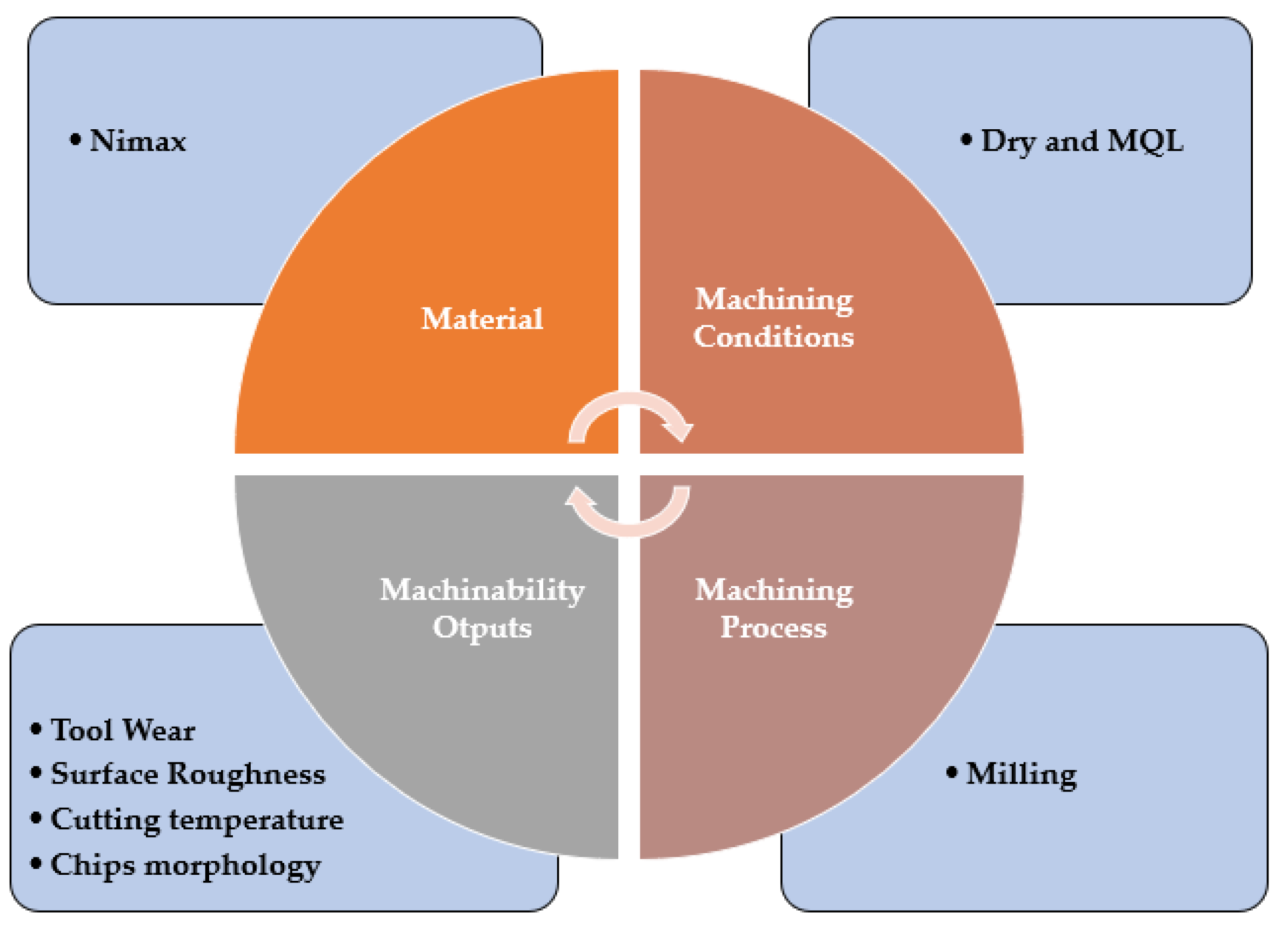
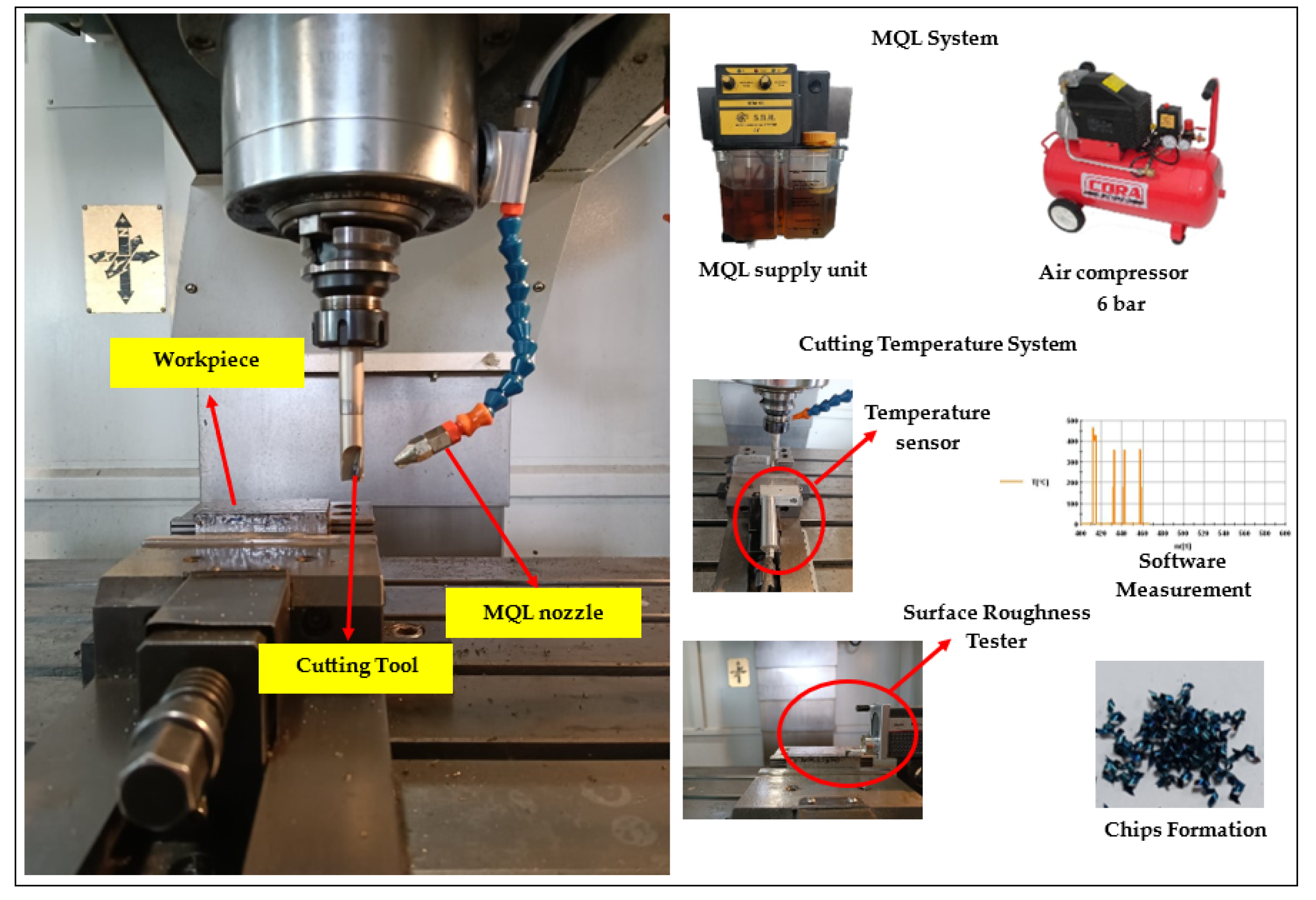
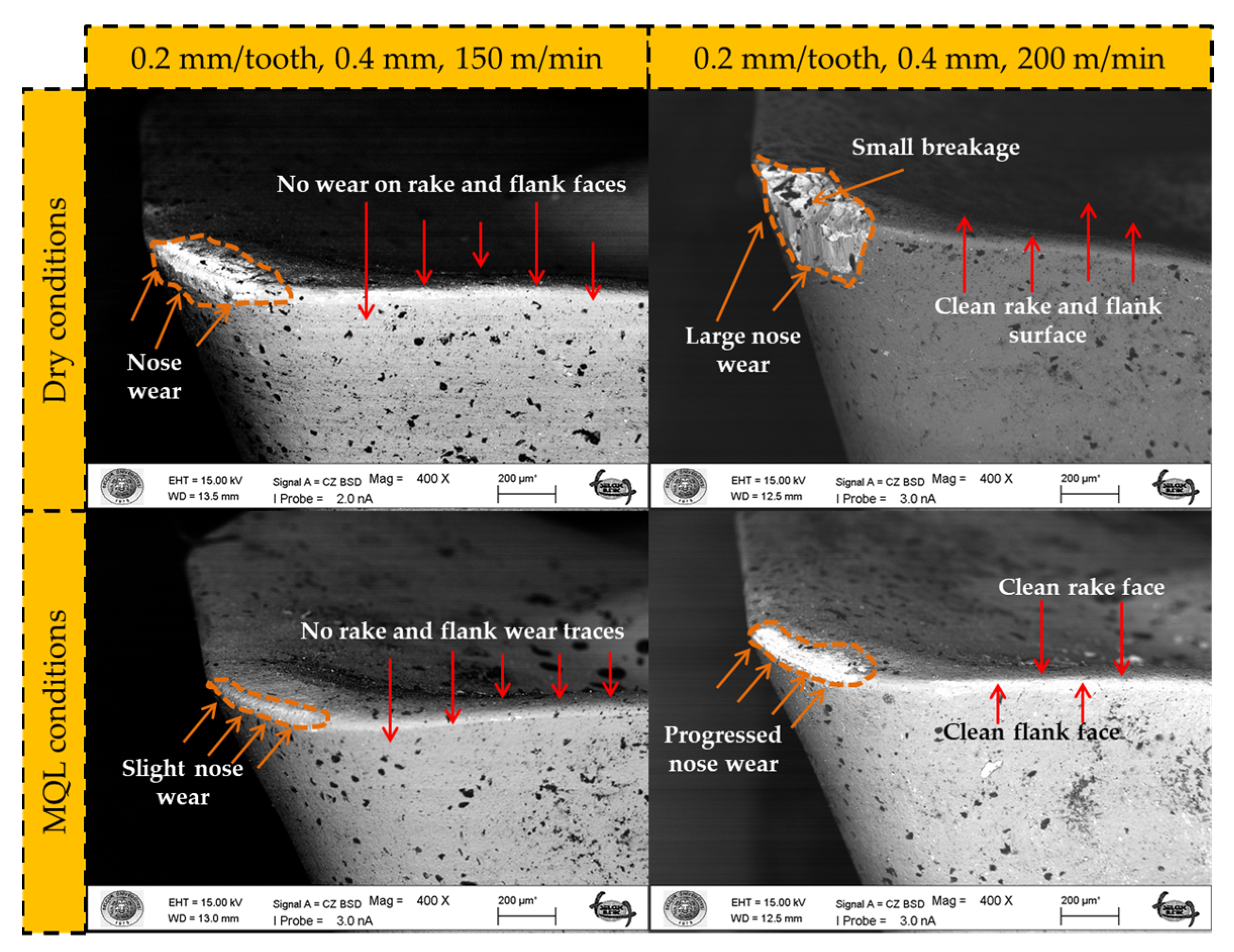

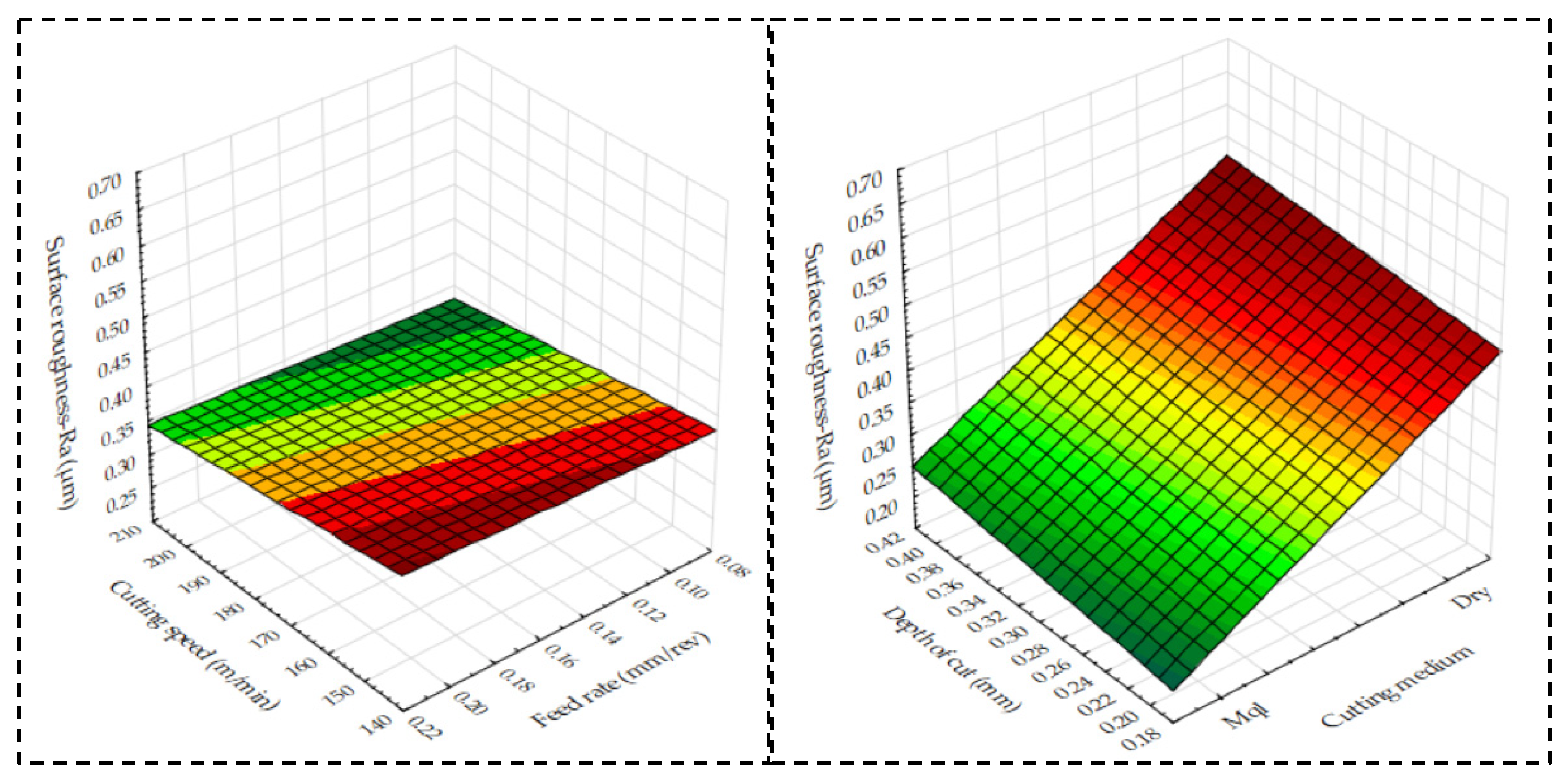
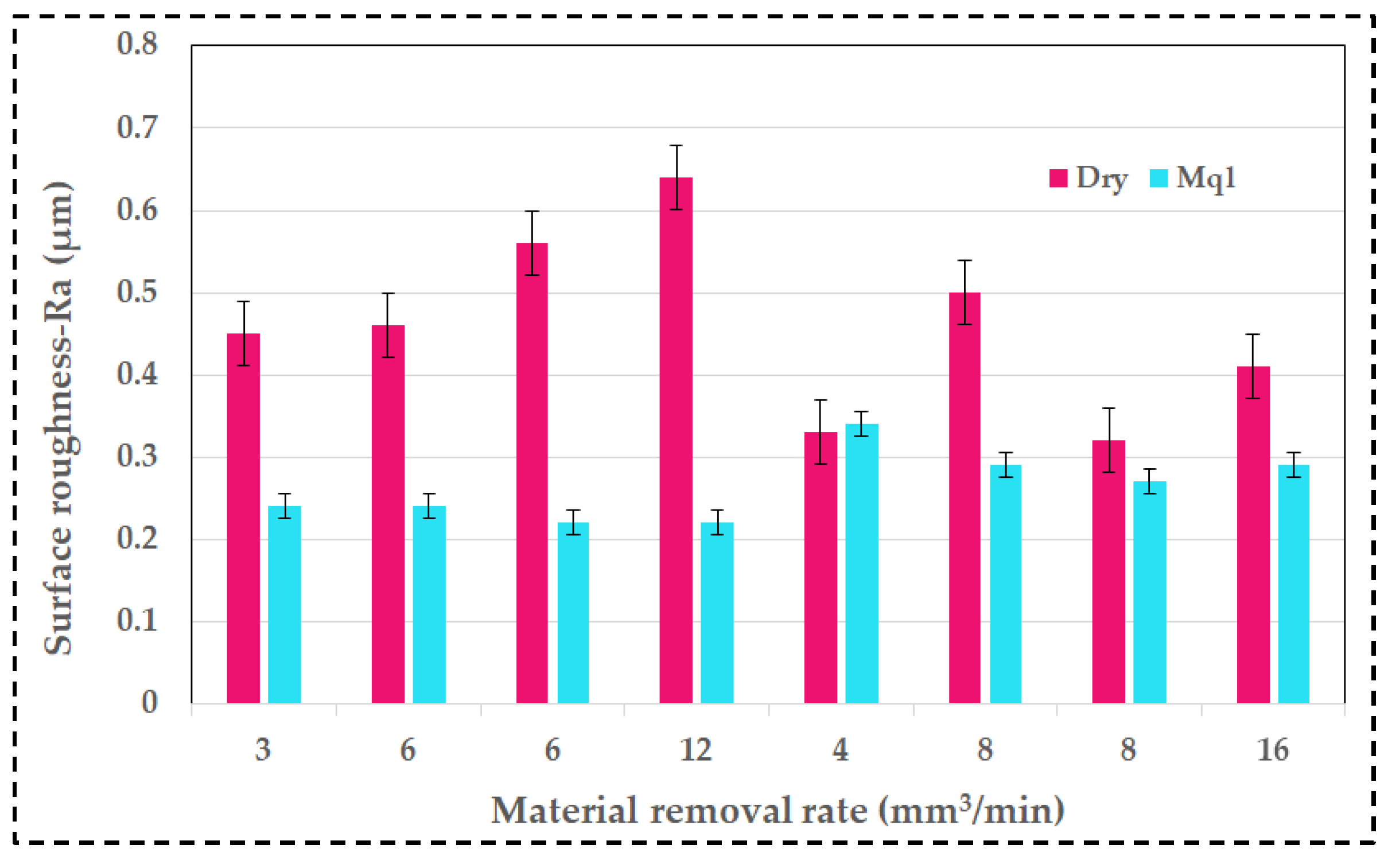

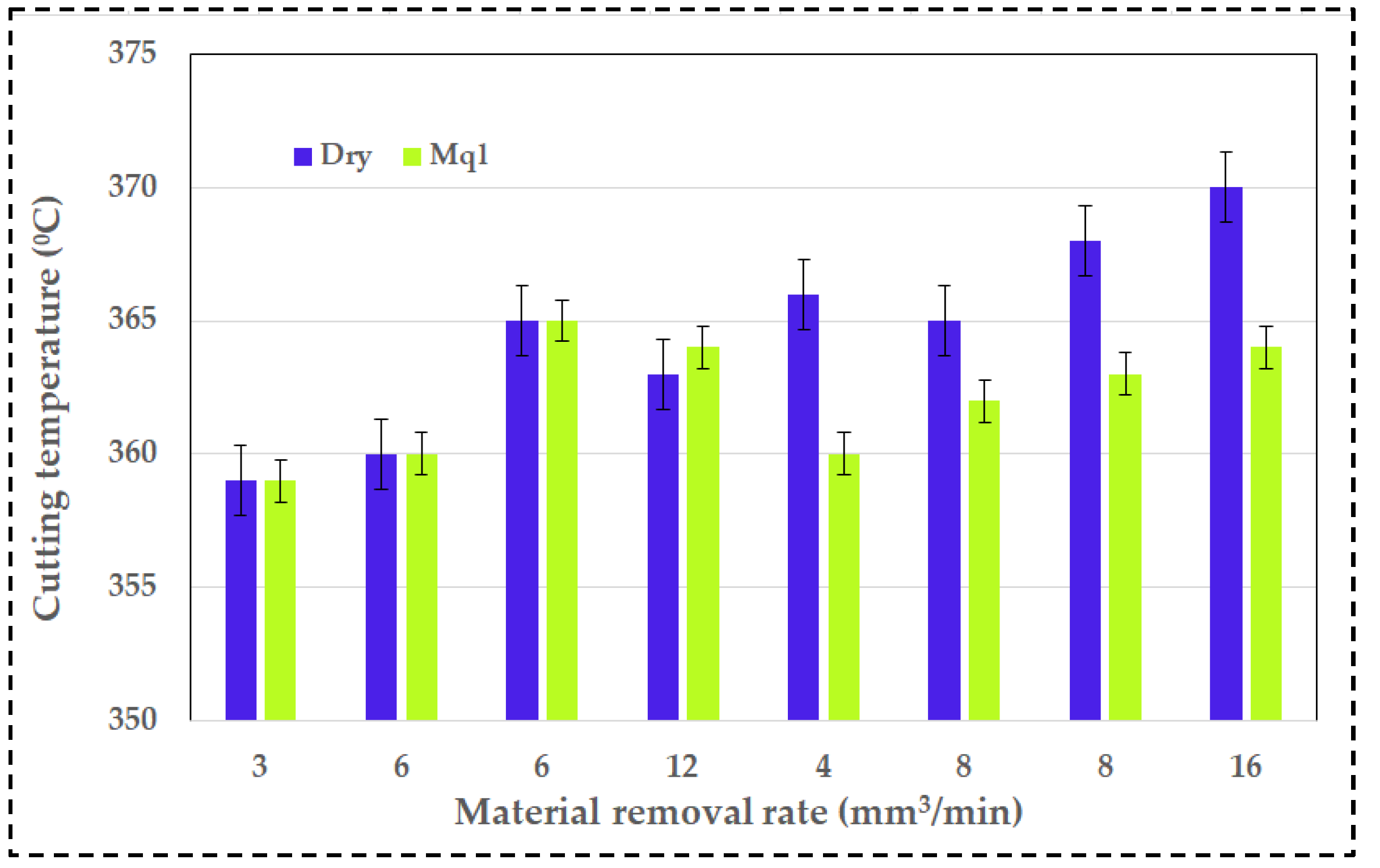

| wt.% | %C | %Si | %Mn | %Cr | %Mo | %Ni |
|---|---|---|---|---|---|---|
| Nimax Sample | 0.1 | 0.3 | 2.5 | 3.0 | 0.3 | 1.0 |
| Machining Parameters | Level 1 | Level 2 | Units |
|---|---|---|---|
| Cutting speed | 150 | 200 | m/min |
| Feed | 0.1 | 0.2 | mm/tooth |
| Cutting depth | 0.2 | 0.4 | mm |
| Regime | Dry | MQL | - |
Disclaimer/Publisher’s Note: The statements, opinions and data contained in all publications are solely those of the individual author(s) and contributor(s) and not of MDPI and/or the editor(s). MDPI and/or the editor(s) disclaim responsibility for any injury to people or property resulting from any ideas, methods, instructions or products referred to in the content. |
© 2023 by the authors. Licensee MDPI, Basel, Switzerland. This article is an open access article distributed under the terms and conditions of the Creative Commons Attribution (CC BY) license (https://creativecommons.org/licenses/by/4.0/).
Share and Cite
Binali, R.; Demirpolat, H.; Kuntoğlu, M.; Sağlam, H. Machinability Investigations Based on Tool Wear, Surface Roughness, Cutting Temperature, Chip Morphology and Material Removal Rate during Dry and MQL-Assisted Milling of Nimax Mold Steel. Lubricants 2023, 11, 101. https://doi.org/10.3390/lubricants11030101
Binali R, Demirpolat H, Kuntoğlu M, Sağlam H. Machinability Investigations Based on Tool Wear, Surface Roughness, Cutting Temperature, Chip Morphology and Material Removal Rate during Dry and MQL-Assisted Milling of Nimax Mold Steel. Lubricants. 2023; 11(3):101. https://doi.org/10.3390/lubricants11030101
Chicago/Turabian StyleBinali, Rüstem, Havva Demirpolat, Mustafa Kuntoğlu, and Hacı Sağlam. 2023. "Machinability Investigations Based on Tool Wear, Surface Roughness, Cutting Temperature, Chip Morphology and Material Removal Rate during Dry and MQL-Assisted Milling of Nimax Mold Steel" Lubricants 11, no. 3: 101. https://doi.org/10.3390/lubricants11030101
APA StyleBinali, R., Demirpolat, H., Kuntoğlu, M., & Sağlam, H. (2023). Machinability Investigations Based on Tool Wear, Surface Roughness, Cutting Temperature, Chip Morphology and Material Removal Rate during Dry and MQL-Assisted Milling of Nimax Mold Steel. Lubricants, 11(3), 101. https://doi.org/10.3390/lubricants11030101






